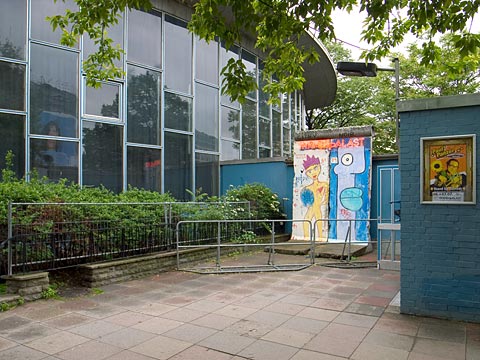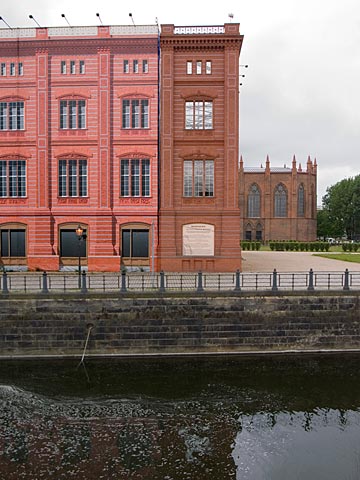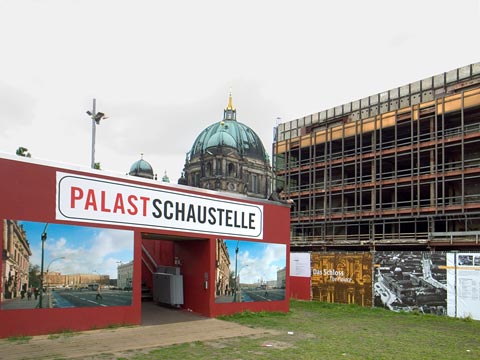Berlin
Day Three
Once again I drove to Potsdamer Platz to begin the day. Not wanting to drive the car into Berlin Mitte where parking is difficult, I took the S-Bahn two stops to the Friedrichstrasse Bahnhof. Before 1989 this was the most common way to enter East Berlin as a visitor. The other, more famous crossing, was Checkpoint Charlie. Friedrichstrasse was also the way out of East Berlin, which was generally impossible for people living behind the Iron Curtain. Retirees, and others with some special dispensation made it across, however. The glass customs hall next to the station was the scene of emotional farewells as friends and relatives returned to the west, hence it's nickname, Traenenpalast, or palace of tears. Today, the building is preserved in somewhat shabby condition as a historic site, and it is currently being used as a music venue. I took several photographs of the building and surrounding area.

Traenenpalast (Palace of Tears)
From there I walked east below the elevated train viaduct stopping to make a photo or two, grabbing a currywurst at a makeshift beer garden across the street from the Pergamon Museum, and eventually reaching Unter den Linden in front of Schinkel's Altes Museum, the Berliner Dom, and the partially demolished Palast der Republik across the street. I walked onto the Schlossplatz, the former site of the earlier Baroque palace, which was torn down after the war by the East Germans. The parade ground thus created was called Marx-Engels Platz and was primarily used as a parking lot for communist party functionaries. Across the Spree, Schinkel's Bauakademie is being recronstructed--one corner of the building is complete--and the rest of the building's volume is wrapped in a printed facsimile of the facade. I was quite taken by the trompe l'oeil effect. It was a cloudy day, but the false facade retained a permanently sunny aspect.

Bauakademie, reconstruction based on design
by Karl Friedrich Schinkel
Turning back to the Palast der Republik, I did two photographs showing the stripped frame of the building and an outdoor exhibition on the history of the site. Both the Prussian era Schloss and the Bauakademie survived the war--with damage--but could have been restored. The German Democratic Republic, short of money, and ideologically charged with cleansing the past, tore the historic structures down. Since the fall of communism, both buildings have been the subject of intense debates within the architectural community and among the public at large. The German parliament has voted to rebuild the pre-war Schloss, or at least some version of it.
Go here for an earlier photograph of the Palast der Republik.

Palast der Republik and exhibition, Berliner Dom
Once again I drove to Potsdamer Platz to begin the day. Not wanting to drive the car into Berlin Mitte where parking is difficult, I took the S-Bahn two stops to the Friedrichstrasse Bahnhof. Before 1989 this was the most common way to enter East Berlin as a visitor. The other, more famous crossing, was Checkpoint Charlie. Friedrichstrasse was also the way out of East Berlin, which was generally impossible for people living behind the Iron Curtain. Retirees, and others with some special dispensation made it across, however. The glass customs hall next to the station was the scene of emotional farewells as friends and relatives returned to the west, hence it's nickname, Traenenpalast, or palace of tears. Today, the building is preserved in somewhat shabby condition as a historic site, and it is currently being used as a music venue. I took several photographs of the building and surrounding area.

Traenenpalast (Palace of Tears)
From there I walked east below the elevated train viaduct stopping to make a photo or two, grabbing a currywurst at a makeshift beer garden across the street from the Pergamon Museum, and eventually reaching Unter den Linden in front of Schinkel's Altes Museum, the Berliner Dom, and the partially demolished Palast der Republik across the street. I walked onto the Schlossplatz, the former site of the earlier Baroque palace, which was torn down after the war by the East Germans. The parade ground thus created was called Marx-Engels Platz and was primarily used as a parking lot for communist party functionaries. Across the Spree, Schinkel's Bauakademie is being recronstructed--one corner of the building is complete--and the rest of the building's volume is wrapped in a printed facsimile of the facade. I was quite taken by the trompe l'oeil effect. It was a cloudy day, but the false facade retained a permanently sunny aspect.

Bauakademie, reconstruction based on design
by Karl Friedrich Schinkel
Turning back to the Palast der Republik, I did two photographs showing the stripped frame of the building and an outdoor exhibition on the history of the site. Both the Prussian era Schloss and the Bauakademie survived the war--with damage--but could have been restored. The German Democratic Republic, short of money, and ideologically charged with cleansing the past, tore the historic structures down. Since the fall of communism, both buildings have been the subject of intense debates within the architectural community and among the public at large. The German parliament has voted to rebuild the pre-war Schloss, or at least some version of it.
Go here for an earlier photograph of the Palast der Republik.

Palast der Republik and exhibition, Berliner Dom

0 Comments:
Post a Comment
Links to this post:
Create a Link
<< Home